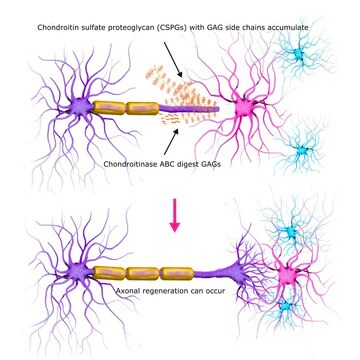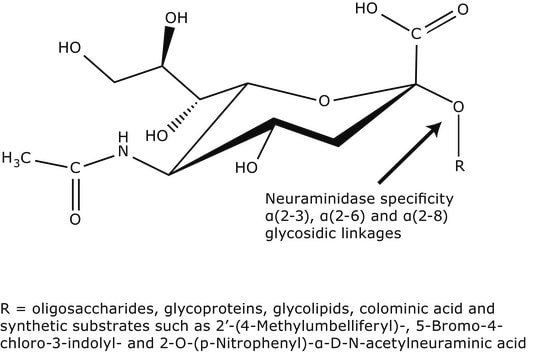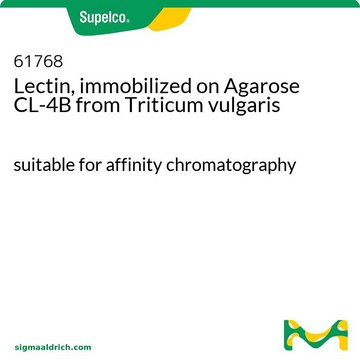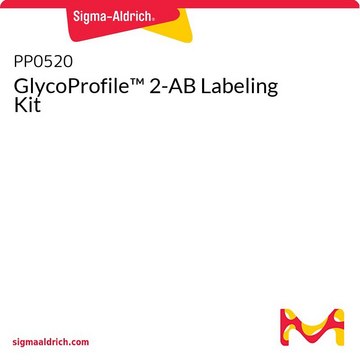E9030
Endoglycoceramidase II from Rhodococcus sp.
aqueous solution
Synonym(s):
EGCase, ceramide glycanase, glycosyl-N-acetyl-sphingosine 1,1-β-D-glucanohydrolase, oligoglycosylglucosyl(1↔1)ceramide glycohydrolase, oligoglycosylglucosylceramide glycohydrolase
Sign Into View Organizational & Contract Pricing
All Photos(1)
About This Item
MDL number:
UNSPSC Code:
12352204
NACRES:
NA.54
Recommended Products
recombinant
expressed in E. coli
Quality Level
conjugate
(Lipid-linked)
form
solution
mol wt
58.9 kDa
shipped in
dry ice
storage temp.
−20°C
Looking for similar products? Visit Product Comparison Guide
Application
Endoglycoceramidase II from Rhodococcus sp. has been used in a study to assess the differentiation of glycosphingolipid-derived glycan structural isomers by liquid chromatography and mass spectrometry. Endoglycoceramidase II from Rhodococcus sp. has also been used in a study to investigate structural and mechanistic analyses of endo-glycoceramidase II.
Unit Definition
One unit will hydrolyze 1 μmol of asialo-GM1 per min at 37 °C at pH 5.0.
Physical form
Solution in 20 mM sodium acetate buffer, pH 6.0, containing 0.2% BSA and 0.1% Lubrol PX.
Storage Class Code
10 - Combustible liquids
WGK
WGK 3
Flash Point(F)
Not applicable
Flash Point(C)
Not applicable
Personal Protective Equipment
dust mask type N95 (US), Eyeshields, Gloves
Choose from one of the most recent versions:
Already Own This Product?
Find documentation for the products that you have recently purchased in the Document Library.
Kentaro Tsukamoto et al.
The Journal of biological chemistry, 280(42), 35164-35171 (2005-08-24)
Clostridium botulinum neurotoxins (BoNTs) act on nerve endings to block acetylcholine release. Their potency is due to their enzymatic activity and selective high affinity binding to neurons. Although there are many pieces of data available on the receptor for BoNT
Hasse Karlsson et al.
Glycobiology, 20(9), 1103-1116 (2010-05-15)
Isolation and characterization of glycosphingolipids is of importance in many aspects of glycobiology, but is difficult to achieve due to the high degree of heterogeneity and isomerism present in these compounds. In this study, oligosaccharides obtained from non-acid glycosphingolipids by
Yohei Ishibashi et al.
Journal of biochemistry, 142(2), 239-246 (2007-06-15)
Endoglycoceramidase is a glycohydrolase capable of hydrolysing the O-glycosidic linkage between oligosaccharides and ceramides of various glycosphingolipids. However, no endoglycoceramidase reported so far can hydrolyse 6-gala series glycosphingolipids which possess the common structure R-Gal beta1-6Gal beta1-1'Cer. Recently, we found a
Y Horibata et al.
Journal of biochemistry, 130(2), 263-268 (2001-08-02)
Endoglycoceramidase (EGCase: EC 3.2.1.123) is an enzyme capable of cleaving the glycosidic linkage between oligosaccharides and ceramides in various glycosphingolipids. We report here transglycosylation and reverse hydrolysis reactions of EGCase from the jellyfish Cynaea nozakii. Various alkyl-GM1 oligosaccharides (alkyl-II(3)NeuAcGgOse4) were
Yohei Ishibashi et al.
The Journal of biological chemistry, 282(15), 11386-11396 (2007-01-25)
Enzymes capable of hydrolyzing the beta-glycosidic linkage between oligosaccharides and ceramides in various glycosphingolipids has been found in microorganisms and invertebrates and designated endoglycoceramidase (EC 3.2.1.123) or ceramide glycanase. Here we report the molecular cloning, characterization, and homology modeling of
Our team of scientists has experience in all areas of research including Life Science, Material Science, Chemical Synthesis, Chromatography, Analytical and many others.
Contact Technical Service







